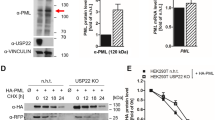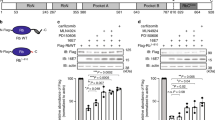Abstract
The retinoblastoma tumor suppressor protein (pRB) is a major regulator of cell-cycle progression and cellular differentiation. Central to pRB function is the pocket domain, which serves as the main binding region for cellular regulators. In tumors pRB is frequently inactivated by mutations in the pocket domain or by binding of viral oncoproteins to this region. A characteristic feature of these viral oncoproteins and many cellular pRB-binding partners is an LxCxE sequence motif, which interacts with pRB's pocket domain. Here, we show that the ubiquitin-like modifier SUMO is covalently attached to a distinct residue (K720) of pRB within the B-box of the pocket region that binds LxCxE-motif proteins. We provide evidence that SUMO preferentially targets the active, hypophosphorylated form of pRB and show that tumorigenic mutations of pRB in the pocket domain lead to a loss of SUMOylation. Notably, the level of pRB SUMOylation is controlled by the interaction of pRB with viral and cellular LxCxE-motif proteins. Inhibitors of pRB function, including the viral oncoproteins E1A and E7 and the cellular E1A-like inhibitor of differentiation EID-1, completely abolish SUMO modification of pRB. Conversely, pRB mutants deficient in binding of LxCxE-motif proteins exhibit a drastically enhanced modification by SUMO. Finally, we provide evidence that SUMOylation can influence pRB function, as the SUMO-deficient pRBK720R mutant exerts a slightly higher repressive potential on an E2F-responsive reporter gene than wild-type pRB. Taken together, these data identify SUMO modification as a novel post-translational modification of pRB that may control pRB activity by modulating LxCxE–pocket interactions.
This is a preview of subscription content, access via your institution
Access options
Subscribe to this journal
Receive 50 print issues and online access
$259.00 per year
only $5.18 per issue
Buy this article
- Purchase on Springer Link
- Instant access to full article PDF
Prices may be subject to local taxes which are calculated during checkout






Similar content being viewed by others
References
Brehm A, Miska EA, McCance DJ, Reid JL, Bannister AJ and Kouzarides T . (1998). Nature, 391, 597–601.
Brown VD and Gallie BL . (2002). Mol. Cell. Biol., 22, 1390–1401.
Chan HM, Krstic-Demonacos M, Smith L, Demonacos C and La Thangue NB . (2001a). Nat. Cell Biol., 3, 667–674.
Chan HM, Smith L and La Thangue NB . (2001b). Oncogene, 20, 6152–6163.
Chen PL, Riley DJ, Chen Y and Lee WH . (1996a). Genes Dev., 10, 2794–2804.
Chen PL, Riley DJ, Chen-Kiang S and Lee WH . (1996b). Proc. Natl. Acad. Sci. USA, 93, 465–469.
Classon M and Harlow E . (2002). Nat. Rev. Cancer, 2, 910–917.
Dahiya A, Gavin MR, Luo RX and Dean DC . (2000). Mol. Cell. Biol., 20, 6799–6805.
David G, Neptune MA and DePinho RA . (2002). J. Biol. Chem., 277, 23658–23663.
Dick FA and Dyson NJ . (2002). J. Virol., 76, 6224–6234.
Dick FA, Sailhamer E and Dyson NJ . (2000). Mol. Cell. Biol., 20, 3715–3727.
Girdwood D, Bumpass D, Vaughan OA, Thain A, Anderson LA, Snowden AW, Garcia-Wilson E, Perkins ND and Hay RT . (2003). Mol. Cell, 11, 1043–1054.
Harbour JW and Dean DC . (2000). Genes Dev., 14, 2393–2409.
Harbour JW, Luo RX, Dei Santi A, Postigo AA and Dean DC . (1999). Cell, 98, 859–869.
Johnson ES and Gupta AA . (2001). Cell, 106, 735–744.
Johnson ES . (2004). Annu. Rev. Biochem., 73, 355–382.
Kagey MH, Melhuish TA and Wotton D . (2003). Cell, 113, 127–137.
Kim HY, Ahn BY and Cho Y . (2001). EMBO J., 20, 295–304.
Kirsh O, Seeler JS, Pichler A, Gast A, Muller S, Miska E, Mathieu M, Harel-Bellan A, Kouzarides T, Melchior F and Dejean A . (2002). EMBO J., 21, 2682–2691.
Knudsen ES and Wang JY . (1996). J. Biol. Chem., 271, 8313–8320.
Lee C, Chang JH, Lee HS and Cho Y . (2002). Genes Dev., 16, 3199–3212.
Lee JO, Russo AA and Pavletich NP . (1998). Nature, 391, 859–865.
Liu H, Dibling B, Spike B, Dirlam A and Macleod K . (2004). Curr. Opin. Genet. Dev., 14, 55–64.
Lukas J, Herzinger T, Hansen K, Moroni MC, Resnitzki D, Helin K, Reed SI and Bartek J . (1997). Genes Dev., 11, 1479–1492.
Luo RX, Postigo AA and Dean DC . (1998). Cell, 92, 463–473.
MacLellan WR, Xiao G, Abdellatif M and Schneider MD . (2000). Mol. Cell. Biol., 20, 8903–8915.
Magnaghi-Jaulin L, Groisman R, Naguibneva I, Robin P, Lorain S, Le Villain JP, Troalen F, Trouche D and Harel-Bellan A . (1998). Nature, 391, 601–605.
Melchior F . (2000). Annu. Rev. Cell. Dev. Biol., 16, 591–626.
Miyake S, Sellers WR, Safran M, Li X, Zhao W, Grossman SR, Gan J, DeCaprio JA, Adams PD and Kaelin Jr WG . (2000). Mol. Cell. Biol., 20, 8889–8902.
Morris EJ and Dyson NJ . (2001). Adv. Cancer Res., 82, 1–54.
Muller S, Berger M, Lehembre F, Seeler JS, Haupt Y and Dejean A . (2000). J. Biol. Chem., 275, 13321–13329.
Muller S, Hoege C, Pyrowolakis G and Jentsch S . (2001). Nat. Rev. Mol. Cell Biol., 2, 202–210.
Muller S, Ledl A and Schmidt D . (2004). Oncogene, 23, 1998–2008.
Nguyen DX, Baglia LA, Huang SM, Baker CM and McCance DJ . (2004). EMBO J., 23, 1609–1618.
Nielsen SJ, Schneider R, Bauer UM, Bannister AJ, Morrison A, O'Carroll D, Firestein R, Cleary M, Jenuwein T, Herrera RE and Kouzarides T . (2001). Nature, 412, 561–565.
Novitch BG, Spicer DB, Kim PS, Cheung WL and Lassar AB . (1999). Curr. Biol., 9, 449–459.
Pichler A, Gast A, Seeler JS, Dejean A and Melchior F . (2002). Cell, 108, 109–120.
Schmidt D and Muller S . (2002). Proc. Natl. Acad. Sci. USA, 99, 2872–2877.
Schmidt D and Muller S . (2003). Cell. Mol. Life Sci., 60, 2561–2574.
Seeler JS and Dejean A . (2003). Nat. Rev. Mol. Cell Biol., 4, 690–699.
Sherr CJ . (2004). Cell, 116, 235–246.
Sherr CJ and McCormick F . (2002). Cancer Cell, 2, 103–112.
Takaki T, Fukasawa K, Suzuki-Takahashi I and Hirai H . (2004). Biochem. Biophys. Res. Commun., 316, 252–255.
Thomas DM, Carty SA, Piscopo DM, Lee JS, Wang WF, Forrester WC and Hinds PW . (2001). Mol. Cell, 8, 303–316.
Verger A, Perdomo J and Crossley M . (2003). EMBO Rep., 4, 137–142.
Wen H and Ao S . (2001). Gene, 263, 85–92.
Xiao B, Spencer J, Clements A, Ali-Khan N, Mittnacht S, Broceno C, Burghammer M, Perrakis A, Marmorstein R and Gamblin SJ . (2003). Proc. Natl. Acad. Sci. USA, 100, 2363–2368.
Yang SH and Sharrocks AD . (2004). Mol. Cell, 13, 611–617.
Zarkowska T and Mittnacht S . (1997). J. Biol. Chem., 272, 12738–12746.
Acknowledgements
We thank Jochen Rech for excellent technical assistance, Alexander Buchberger and Olaf Stemmann for critical reading of the manuscript and Stefan Jentsch for helpful discussions and continuous support. Our work is supported by the Deutsche Forschungsgemeinschaft and the German Israeli Foundation for Development and Scientific Research.
Author information
Authors and Affiliations
Electronic supplementary material
Rights and permissions
About this article
Cite this article
Ledl, A., Schmidt, D. & Müller, S. Viral oncoproteins E1A and E7 and cellular LxCxE proteins repress SUMO modification of the retinoblastoma tumor suppressor. Oncogene 24, 3810–3818 (2005). https://doi.org/10.1038/sj.onc.1208539
Received:
Revised:
Accepted:
Published:
Issue Date:
DOI: https://doi.org/10.1038/sj.onc.1208539
Keywords
This article is cited by
-
Protein post-translational modifications in the regulation of cancer hallmarks
Cancer Gene Therapy (2023)
-
Post-translational modifications on the retinoblastoma protein
Journal of Biomedical Science (2022)
-
SUMO and the robustness of cancer
Nature Reviews Cancer (2017)
-
SENP1-modulated sumoylation regulates retinoblastoma protein (RB) and Lamin A/C interaction and stabilization
Oncogene (2016)
-
Kaposi’s sarcoma-associated herpesvirus lana2 protein interacts with the pocket proteins and inhibits their sumoylation
Oncogene (2014)



